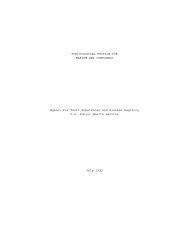Comparison of Disintegration Methods at a Full-scale ... - BVSDE
Comparison of Disintegration Methods at a Full-scale ... - BVSDE
Comparison of Disintegration Methods at a Full-scale ... - BVSDE
Create successful ePaper yourself
Turn your PDF publications into a flip-book with our unique Google optimized e-Paper software.
Using these curves, the cost efficiency can be estim<strong>at</strong>ed. If for example a WWTP with an influent<br />
flow <strong>of</strong> 50,000 m³/d and specific disposal costs <strong>of</strong> 300 Euro/Mg can achieve an increase in the<br />
vol<strong>at</strong>ile solids reduction <strong>of</strong> more than 30 % (from 45 to more than 58.5 %), the install<strong>at</strong>ion <strong>of</strong> a<br />
disintegr<strong>at</strong>ion device on the plant will save costs.<br />
In this investig<strong>at</strong>ion the best results were obtained using the stirred ball mill (see Figure 2),<br />
although cost efficiency was not achieved on the basis <strong>of</strong> the model WWTP <strong>of</strong> 100,000 PE (20,000<br />
m³/d). With an increase in vol<strong>at</strong>ile solids reduction <strong>of</strong> 26 % and specific disposal costs <strong>of</strong> 400<br />
Euro/Mg TS it can be derived from Figure 3 th<strong>at</strong> cost efficiency can be reached for WWTP <strong>of</strong> more<br />
than 50,000 m³/d tre<strong>at</strong>ment capacity.<br />
Conclusions<br />
<strong>Disintegr<strong>at</strong>ion</strong> <strong>of</strong> excess sludge is a possible pre-tre<strong>at</strong>ment to optimise anaerobic digestion. This has<br />
been shown already in various half-<strong>scale</strong> and lab-<strong>scale</strong> investig<strong>at</strong>ions. To valid<strong>at</strong>e these results two<br />
stirred ball mills, oxid<strong>at</strong>ion with ozone, a lys<strong>at</strong>e centrifuge and an ultrasonic homogeniser were<br />
investig<strong>at</strong>ed <strong>at</strong> a full-<strong>scale</strong> plant in Schermbeck.<br />
In continuous oper<strong>at</strong>ion a constant quality <strong>of</strong> disintegr<strong>at</strong>ed sludge could be produced with all<br />
aggreg<strong>at</strong>es. A positive influence <strong>of</strong> disintegr<strong>at</strong>ion on the anaerobic biodegradability could be<br />
established. The enhancement <strong>of</strong> the degree <strong>of</strong> degrad<strong>at</strong>ion varied between 7.4 % and 26 %.<br />
Labor<strong>at</strong>ory investig<strong>at</strong>ions valid<strong>at</strong>ed th<strong>at</strong> disintegr<strong>at</strong>ion increases the polymer demand and leads to a<br />
lower solid content after dew<strong>at</strong>ering. Higher ammonia concentr<strong>at</strong>ions in the process w<strong>at</strong>er after<br />
dew<strong>at</strong>ering corrobor<strong>at</strong>ed the results <strong>of</strong> the anaerobic degrad<strong>at</strong>ion.<br />
A balance <strong>of</strong> costs and pr<strong>of</strong>it from disintegr<strong>at</strong>ion was estim<strong>at</strong>ed. The main part <strong>of</strong> pr<strong>of</strong>it is made<br />
up from the minimis<strong>at</strong>ion <strong>of</strong> disposal costs because <strong>of</strong> a decreased amount <strong>of</strong> sludge resulting from<br />
the higher degree <strong>of</strong> degrad<strong>at</strong>ion. The economic efficiency <strong>of</strong> a disintegr<strong>at</strong>ion is mainly influenced<br />
by the achieved improvement <strong>of</strong> the anaerobic degrad<strong>at</strong>ion, the specific disposal costs <strong>of</strong> the sludge<br />
and the size <strong>of</strong> the WWTP. If the development <strong>of</strong> costs and the current discussion about sludge<br />
disposal is taken into account, sewage sludge disintegr<strong>at</strong>ion can be a suitable technique for<br />
minimising costs <strong>at</strong> waste w<strong>at</strong>er tre<strong>at</strong>ment plants.<br />
Acknowledgements<br />
The research project is a cooper<strong>at</strong>ion project funded by the BMBF (Ministry for Research and<br />
Educ<strong>at</strong>ion) within the four cooper<strong>at</strong>ion partners Emschergenossenschaft/Lipperverband, Institute <strong>of</strong><br />
Sanitary and Environmental Engineering from the Technical University <strong>of</strong> Braunschweig, the<br />
Emschergesellschaft für Wassertechnik and the company Aw<strong>at</strong>ech. We would also like to thank the<br />
companies Netzsch Feinmahltechnik, Draiswerke, Wedeco, Hiller and Sonotronic for making their<br />
aggreg<strong>at</strong>es and manpower available.<br />
References<br />
ATV Arbeitsgruppe 3.1.6 (2000). Verfahren und Anwendungsgebiete der mechanischen Klärschlammdesintegr<strong>at</strong>ion,<br />
Teil 1 des Arbeitsberichts, Korrespondenz Abwasser 4/2000, pp. 571-576<br />
ATV Arbeitsgruppe 3.1.6 (2001). Verfahrensvergleich und Ergebnisse der mechanischen Klärschlammdesintegr<strong>at</strong>ion,<br />
Teil 2 des Arbeitsberichts, Korrespondenz Abwasser 3/2001, pp. 393-400<br />
Friedrich, H. (2000). Schlamm im Schall – voll desintegriert, Umweltmagazin Nov./Dez. 2000, pp. 57-58<br />
Kopp J. and Dichtl N. (1998). Influence <strong>of</strong> Surface Charge and Exopolysaccharids on the Conditioning Characteristics<br />
<strong>of</strong> Sewage Sludge. In: Chemical W<strong>at</strong>er and Wastew<strong>at</strong>er Tre<strong>at</strong>ment. Hahn H., H<strong>of</strong>fmann E. and H. ∅degaard (ed),<br />
Springer-Verlag, Berlin Heidelberg, New York, pp. 285-296<br />
Kopp J. and Dichtl. N. (2001). Influence <strong>of</strong> the free w<strong>at</strong>er content on the dew<strong>at</strong>erability <strong>of</strong> sewage sludge. In: Sludge<br />
Management Entering the 3 rd Millennium – Industrial, Combined, W<strong>at</strong>er and Wastew<strong>at</strong>er Residues, Taipei Taiwan, pp.<br />
270-275<br />
Müller J. (2000). Sludge management for the 21 st century: <strong>Disintegr<strong>at</strong>ion</strong> as a key-step in sewage sludge tre<strong>at</strong>ment. W<strong>at</strong>.<br />
Sci. Techn., 41(8), pp. 123-130<br />
Neis U., Nickel K. and Thiem A. (1999). Enhancement <strong>of</strong> anaerobic sludge digestion by Ultrasonic <strong>Disintegr<strong>at</strong>ion</strong>. In:<br />
Disposal and Utilis<strong>at</strong>ion <strong>of</strong> Sewage sludge - Tre<strong>at</strong>ment <strong>Methods</strong> and Applic<strong>at</strong>ion Modalities, Athen, pp.129-136<br />
579
















